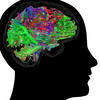You are here
What Lies Beneath the Brain’s GPS

Location and orientation in space is essential to the survival of all animals, including humans. As early as the 1940s, the US psychologist Edward Tolman1 suggested that this ability to move from one point to another in an optimum manner was based on our capacity to make and use a mental map of our environment. Various cognitive processes govern our ability to navigate in space: constant tracking of our position, representations of the environment that take account of external stimuli, and the planning and execution of trajectories.
How does our brain, and the neuronal networks it contains, enable us to perform such tasks? The cognitive neurosciences are now providing increasingly precise answers to this fundamental question, as testified by recent work from the Spatial Cognition team led by Francesca Sargolini at the Laboratory of Cognitive Neuroscience (LNC) in Marseille (southeastern France),2 and published in Nature Communications.3
Neurons for “where”
Two types of neuron, initially identified in the rat, are known to be key actors in spatial memorisation and navigation: place cells (located in the hippocampus) and grid cells situated in another part of the brain called the entorhinal cortex. The former, discovered in 1971 by the British-American neuroscientist John O’Keefe, are activated when an animal finds itself at a specific point in space; they thus express a unique location, similar to “You are here” on a town map. As for grid cells, evidenced in 2005 by the Norwegian neuroscientists May-Britt Moser and her husband Edvard, they are fired at several sites that cover the entire space explored by the animal, in the same way as a grid on a city map.



These two populations of "spatial" neurons act as the brain’s GPS, enabling individuals to determine their position in real-time and thus orient themselves in space. This discovery earned the three scientists the Nobel Prize for Physiology and Medicine in 2014.
But what information do these neuronal cells use to construct the data for the brain’s GPS? During her postdoctoral studies in the Mosers’ laboratory, Francesca Sargolini suggested that unlike place cells that are activated by information from the external environment (visual, olfactory and auditory cues), grid cells, which supply the metrics of space, depend on information related to the movement of an individual.
“There is nothing else so permanent in the environment that can explain this extremely regular representation of space, which is why we proposed the hypothesis that grid cell firing could not be based solely on external reference points but also on information supplied by internal movement sensors, such as proprioceptiveFermerThey enable perception of the position and movements of each part of our body., muscle tension or inner ear receptors,” explains the scientist. But it remained to be proved.
Activity guided by movements
This has now been achieved by Francesca Sargolini and her team, who for the first time have established the respective contributions of the different sources of information – individual movement, external environment – to the genesis of the spatial activity of grid cells. To obtain their results, the scientists trained rats to explore various environments; in this case an arena (a 1.5 metre circular box) and a circular track. Throughout the duration of each rat’s movements, they recorded the positions of both the animal and its head in real time, as well as the firing of its grid cells, using electrodes implanted in the entorhinal cortex.



This enabled them to study potential correlations between neuronal activity and several other variables that come into play when the animal is in motion: time elapsed, movements made, distances covered, presence of visual cues in the environment, etc.
“After comparing our experimental findings with those obtained using models to simulate grid cell firing, established on the sole basis of movement-related data or environmental reference points, or a combination of both, we were able to show that 80% of grid cell activity is guided by internal information generated by the animal’s movement, and 20% by environmental cues – mainly visual – but never by time,” explains Pierre-Yves Jacob, who conducted the study as part of his postdoc at the LNC.
Our metrics of space therefore mainly relies on implementing and then memorising our movements.
4
Furthermore, comparisons of the different grid architectures derived from these experiments revealed that the amount of information available in the external environment affects the resolution of these grids: the more numerous the visual cues, the tighter the grid, and vice versa. These novel findings are based on an equally extraordinary technical feat, as the LNC team is at present the only one in France to be able to record the specific firing of grid cells.



Applications in robotics
Although conducted in the rat, this work proves essential for elucidating the functioning of the brain structures involved in the human spatial navigation system. Although potential applications in the medical field remain highly prospective, these findings are already being exploited in the robotics sector. “The advances achieved in understanding the functioning of ‘spatial’ neuron networks – both place and grid cells – are of considerable interest to robotics specialists, such as those working in the Neurocybernetics team at the Information Processing and System Teams (ETIS) laboratory, with whom we collaborate on a regular basis. Indeed, they enable them to model neural mechanisms, reproduce artificial networks inspired by those found in nature and implement them in robots so as to improve their perception of the surrounding environment, help them interact with it and move around autonomously,” concludes Francesca Sargolini.
- 1. 1886-1959.
- 2. CNRS / Aix Marseille Université.
- 3. “Path integration maintains spatial periodicity of grid cell firing in a 1D circular track”, Francesca Sargolini et al., Nature Communications, 10, 850, February 2019.
- 4. CNRS / École Nationale Supérieure de l’Electronique et de ses Applications / Université de Cergy-Pontoise.
Explore more
Author
Stéphanie Belaud has been a scientific writer for more than ten years. She specializes in biology, medicine and the environment.











